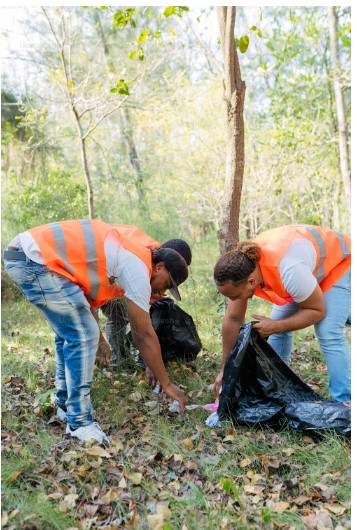Nature Walks Mental Health: Combining Fitness and Environment
Introduction
Are you tired of the daily grind and seeking an escape from the concrete jungle? Look no further than nature walks for a revitalizing experience that benefits both your physical and mental well-being. Combining fitness with environmentalism, these walks offer the perfect opportunity to reconnect with nature while reaping the numerous mental health benefits that come with it.
Research has shown that spending time in nature can reduce stress, improve mood, and boost cognitive function. Nature walks provide a break from technology and the fast-paced demands of everyday life, allowing you to immerse yourself in the calming sights and sounds of the natural world.
Engaging in physical activity during these walks not only improves your cardiovascular health but also releases endorphins, the body’s natural mood-enhancing chemicals. Whether you prefer a leisurely stroll through a local park or a more challenging hike in the wilderness, there are nature walks suitable for all fitness levels.
By promoting a sense of mindfulness and connection with the environment, nature walks provide a unique opportunity to enhance your overall well-being. So, lace up your hiking boots, embrace the beauty of nature, and find solace in the nourishing power of the great outdoors.
The Connection between Nature and Mental Health
Spending time in nature has long been recognized as a powerful tool for promoting mental health and well-being. The natural world offers a respite from the stressors of modern life, allowing us to reconnect with our senses and find solace in the beauty around us.
Studies have shown that exposure to natural environments can reduce stress levels and improve mood. The calming sights and sounds of nature have a soothing effect on the mind, helping to alleviate anxiety and depression. Additionally, spending time in nature has been found to enhance cognitive function, including attention and memory.
Nature walks, in particular, allow us to fully immerse ourselves in the natural environment, providing a sense of peace and tranquility. The rhythmic motion of walking combined with the beauty of the surrounding landscape creates a meditative experience that calms the mind and promotes mental clarity.
Benefits of Combining Fitness with Environmentalism
Nature walks not only benefit our mental health but also provide an opportunity to engage in environmentalism. By combining fitness with a love for the natural world, we can contribute to the preservation and protection of our planet.
Participating in nature walks allows us to develop a deeper appreciation for the environment. As we explore forests, mountains, or coastal trails, we become more aware of the delicate balance of ecosystems and the importance of conserving them. This awareness can drive us to take action in our daily lives to minimize our environmental footprint and advocate for sustainable practices.
Furthermore, nature walks provide a platform for education and awareness. By joining guided walks or participating in community-led initiatives, we can learn about local flora and fauna, as well as the challenges they face. This knowledge equips us to become better stewards of the environment and actively participate in conservation efforts.
The Physical and Mental Health Benefits of Nature Walks
Nature walks offer a wide range of physical and mental health benefits. Engaging in regular outdoor activity not only improves cardiovascular health but also strengthens muscles, improves flexibility, and boosts overall fitness.
The physical exertion involved in nature walks releases endorphins, the body’s natural mood-enhancing chemicals. These endorphins create a sense of well-being and can help alleviate symptoms of anxiety and depression. Additionally, being in nature provides a welcome distraction from the pressures of daily life, allowing us to temporarily let go of our worries and focus on the present moment.
Nature walks also offer a unique opportunity for social connection and community engagement. Joining group walks or participating in organized nature events allows us to meet like-minded individuals who share our love for the outdoors. These connections can provide a support network and foster a sense of belonging and camaraderie.
Environmental Benefits of Nature Walks
In addition to the personal benefits, nature walks have a positive impact on the environment. By exploring natural landscapes, we develop a deeper understanding of the ecosystems and the need to protect them.
Nature walks can serve as a form of environmental education, raising awareness about local biodiversity, conservation efforts, and sustainable practices. As we learn about the fragile balance of ecosystems, we become more motivated to take action and make environmentally conscious choices in our daily lives.
Furthermore, nature walks often take place in protected areas, such as national parks or nature reserves. By visiting these areas, we contribute to their economic viability, supporting the maintenance and preservation of these natural treasures.
How to Incorporate Nature Walks into Your Fitness Routine
Incorporating nature walks into your fitness routine is easier than you might think. There are various ways to enjoy the great outdoors while reaping the physical and mental health benefits of walking in nature.
- Start by identifying local nature trails and parks in your area. Research online or consult local hiking or nature organizations for recommendations. Look for trails that suit your fitness level and preferences.
- Invest in a good pair of hiking shoes or comfortable walking sneakers. Having the right footwear will ensure a comfortable and safe experience.
- Plan your walks according to your schedule. Whether it’s a short walk during your lunch break or a longer weekend hike, find a time that works for you. Consider the weather conditions and dress appropriately.
- Invite friends or family members to join you. Walking in nature is more enjoyable when shared with loved ones. It’s a great way to connect and spend quality time together while reaping the benefits of nature.
- Gradually increase the distance and difficulty of your walks as your fitness level improves. Challenge yourself to explore new trails and push your limits.
Remember to stay hydrated, bring snacks, and pack a small backpack with essentials such as a map, sunscreen, insect repellent, and a first aid kit. Safety should always be a priority when venturing into nature.
Finding Local Nature Trails and Parks
Finding local nature trails and parks is easier than ever, thanks to the wealth of information available online. Here are a few resources to help you discover the natural wonders in your area:
- Local tourism websites: Many cities and towns have tourism websites that provide information on local attractions, including nature trails and parks. These websites often include maps, trail descriptions, and visitor information.
- AllTrails: AllTrails is a popular online platform that provides a comprehensive database of trails worldwide. You can search for trails based on location, difficulty level, and user reviews. The platform also offers a mobile app for easy access on the go.
- National Park Service: If you’re interested in exploring national parks, the National Park Service website is a valuable resource. It provides detailed information on parks, including trail maps, visitor centers, and park regulations.
- Local hiking and nature organizations: Connect with local hiking or nature organizations in your area. These groups often organize guided walks, educational programs, and community events centered around nature. They can provide valuable insights and recommendations for nearby trails.
Remember to check for any permits or restrictions before visiting certain areas. Some trails may require advance reservations or have specific regulations in place to protect the environment.
Safety Tips for Nature Walks
While nature walks offer numerous benefits, it’s essential to prioritize safety to ensure an enjoyable experience. Here are some safety tips to keep in mind:
- Research the trail beforehand: Familiarize yourself with the trail’s difficulty level, length, and terrain. Read reviews or consult experienced hikers to get an idea of what to expect.
- Dress appropriately: Wear comfortable and weather-appropriate clothing. Dress in layers to accommodate changing temperatures. Don’t forget to wear a hat and sunscreen to protect yourself from the sun’s rays.
- Stay hydrated: Carry an adequate amount of water to keep yourself hydrated throughout the walk. Dehydration can lead to fatigue and other health issues.
- Bring essential supplies: Pack a small backpack with essentials such as a map, compass, flashlight, whistle, first aid kit, and snacks. It’s always better to be prepared for any unforeseen circumstances.
- Stay on marked trails: Stick to designated trails to minimize the impact on the environment and reduce the risk of getting lost. Straying off the path can harm fragile ecosystems and increase the chances of accidents.
- Be aware of wildlife: Respect the natural habitat of wildlife and maintain a safe distance. Avoid feeding or approaching animals, as this can disrupt their natural behavior and pose a risk to both you and the animals.
- Let others know your plans: Inform someone about your intended route and estimated time of return. This way, someone will be aware of your whereabouts in case of an emergency.
By following these safety tips, you can enjoy nature walks while minimizing risks and ensuring a safe experience for yourself and the environment.
Environmental Activism and Advocacy through Nature Walks
Nature walks not only allow us to connect with the environment on a personal level but also provide an opportunity for environmental activism and advocacy. Here’s how you can make a difference through your nature walks:
- Participate in organized clean-up events: Many hiking and nature organizations organize clean-up events where participants collect litter and restore the natural beauty of trails and parks. By joining these events, you contribute to the preservation of the environment and inspire others to do the same.
- Educate others: Share your knowledge and experiences with friends, family, and fellow nature enthusiasts. Spread awareness about the importance of environmental conservation and sustainable practices. Encourage others to join nature walks and discover the healing power of nature for themselves.
- Support local conservation efforts: Research local conservation organizations working to protect natural areas in your region. Consider volunteering your time, donating, or participating in fundraising events to support their initiatives.
- Practice Leave No Trace principles: When venturing into nature, adhere to the Leave No Trace principles. These guidelines include packing out your trash, minimizing campfire impacts, respecting wildlife, and staying on designated trails. By practicing these principles, you help preserve the integrity of natural areas for future generations.
Combining Nature Walks with Other Eco-Friendly Activities
Nature walks can be enhanced by combining them with other eco-friendly activities. Here are a few ideas to amplify your connection with nature and contribute to a sustainable lifestyle:
- Birdwatching: Bring along a pair of binoculars and a bird identification book to observe and learn about local bird species. Birdwatching is an excellent way to connect with nature and contribute to citizen science projects.
- Photography: Capture the beauty of nature through photography. Develop your skills by experimenting with different angles, lighting, and subjects. Share your photos on social media to inspire others to appreciate and protect the environment.
- Journaling: Bring a journal and pen on your nature walks to document your thoughts, observations, and reflections. Journaling allows you to deepen your connection with nature and serves as a reminder of the healing power of the natural world.
- Nature-inspired art: Use your creative skills to create art inspired by nature. Paint, draw, or create sculptures using natural materials found during your walks. Display your artwork at local galleries or share them online to inspire others.
Remember, every small action counts. By combining nature walks with other eco-friendly activities, you can make a positive impact on the environment and encourage others to do the same.
Conclusion: Embracing the Healing Power of Nature Walks
Nature walks offer a powerful and rejuvenating experience for both our physical and mental well-being. By immersing ourselves in the beauty of the natural world, we can reduce stress, improve mood, and boost cognitive function.
Combining fitness with environmentalism through nature walks not only benefits us personally but also contributes to the preservation of our planet. By developing a deeper appreciation for the environment, educating ourselves and others, and actively engaging in environmental activism, we can make a difference in protecting the natural wonders around us.
So, lace up your hiking boots, embrace the healing power of nature, and embark on a journey that nourishes your mind, body, and soul. Nature is waiting to welcome you with open arms.






